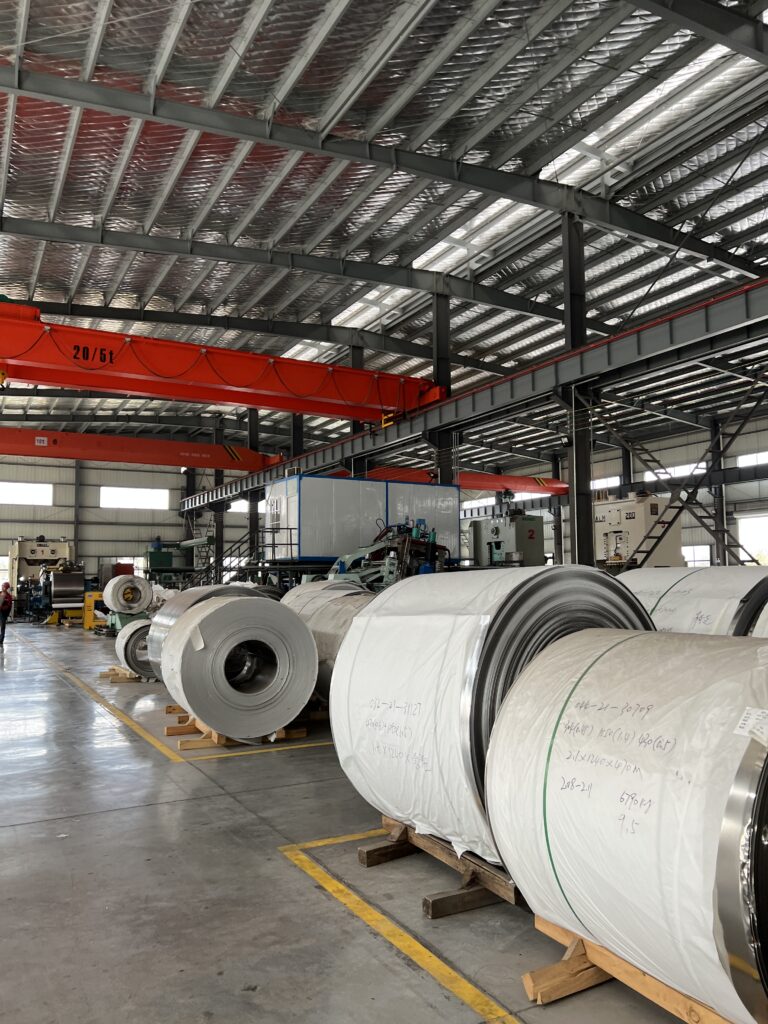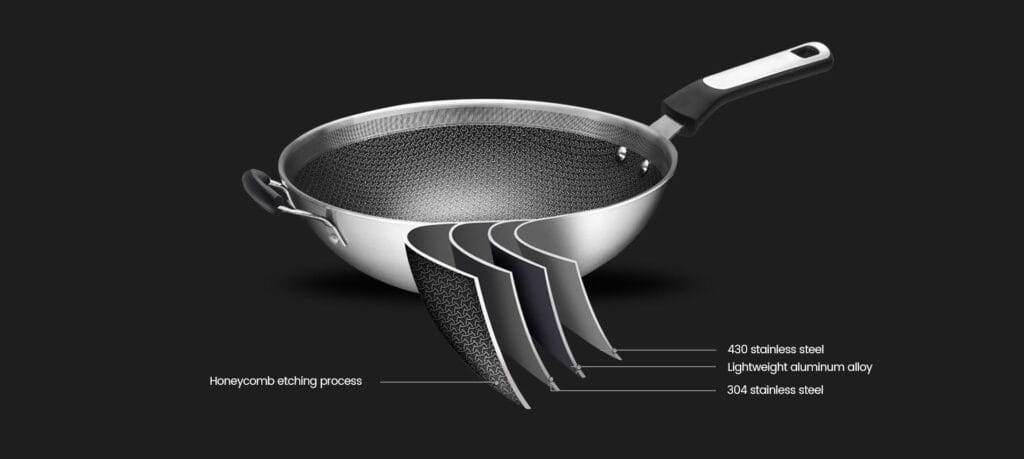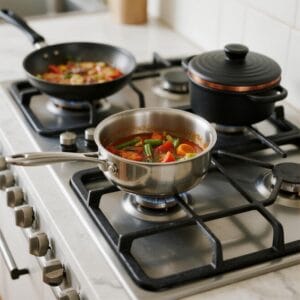
Triply Circle Production Process: High-Quality Manufacturing
In the world of manufacturing cookware products, the quality of the raw material and how exact you are with your production processes are vital to how good the end product is. We specialize in manufacturing high-quality triply circles at SenJun Trading. My factory is world class, new, efficient, and full of skilled people that enable us to make the world’s best triply circles for cookware. In this blog, I would like to take you behind the scenes at my factory, and right up to where we bring in the raw material to make the finished good.
The Triply Circle Production Process: Step-by-Step
Making triply circles involves a tricky process where we use high-tech machines, highly skilled people, and rigorous quality control. Here are the step-by-step directions to produce our high-quality triply circles.
a. Material Selection and Preparation
The first step in the production process is selecting premium materials. Triply circles are typically made from three layers: an inner layer of high-grade stainless steel, a core layer of aluminum, and an outer layer of stainless steel or other materials like copper or titanium.
- Stainless Steel (Inner and Outer Layers): Provides corrosion resistance, a non-reactive cooking surface, and structural strength.
- Aluminum (Core Layer): Ensures excellent heat distribution and thermal conductivity.
Once the materials are selected, they are cut into sheets and inspected for quality to ensure they meet our rigorous standards.
b. Cladding and Bonding
The metal sheets are then bonded together using advanced cladding technology. This involves applying extreme heat and pressure to fuse the layers into a single, durable sheet. Our factory uses high-tech rolling mills and cladding equipment to ensure the layers are perfectly bonded without any gaps, which is critical for achieving uniform heat distribution in the final cookware.
c. Circle Cutting and Shaping
After cladding, the bonded sheets are cut into circles using precision cutting machines. These circles are then shaped to meet specific size requirements, ranging from 100mm to 1240mm in diameter, depending on the needs of our clients. Our cutting technology ensures smooth edges and exact dimensions, reducing material waste and improving production efficiency.
d. Surface Finishing
The circles undergo a finishing process to enhance their appearance and functionality. This includes polishing the surface to a mirror or satin finish, which not only improves the aesthetic appeal but also adds an additional layer of corrosion resistance. The finished surface is smooth and free of defects, making it ideal for further manufacturing into cookware.
e. Quality Control and Inspection
Every triply circle produced at SenJun Trading goes through a rigorous quality control process. This includes visual inspections, dimensional checks, and material composition testing. We use advanced non-destructive testing (NDT) methods such as ultrasonic and X-ray inspections to detect any internal flaws, ensuring that only the highest quality circles are supplied to our customers.
f. Packaging and Delivery
Once inspected and approved, the triply circles are carefully packaged to prevent any damage during transport. We offer flexible packaging options, including wooden cases or custom packaging as per client requirements, to ensure that the product reaches you in perfect condition.

Introducing Our Factory: Where Quality Meets Innovation
SenJun Trading operates a modern manufacturing facility equipped with international-standard production and testing equipment. Our factory is staffed by a team of skilled professionals dedicated to producing high-quality triply circles and other metal composite materials.
Our Factory Highlights:
- Advanced Production Lines: Our facility includes multiple cladding, rolling, and cutting lines, allowing us to produce a wide range of triply circles with precision and efficiency.
- Skilled Workforce: Our team of engineers and technicians are trained to handle the latest machinery and adhere to strict quality standards throughout the production process.
- Stringent Quality Control: We employ comprehensive testing methods at each stage of production to ensure that every circle meets our high standards.
- Sustainable Practices: We are committed to sustainable manufacturing, minimizing waste through efficient production processes and recycling scrap materials.






SenJun Trading’s Product Offering
At SenJun Trading, we provide high-quality triply cookware circles, ideal for manufacturing top-tier kitchen products. Our products include:
- Materials:
- Stainless Steel 304/430 + Aluminum 1050 combinations, ensuring excellent corrosion resistance and heat conductivity.
- Specifications:
- Thickness: Ranges from 1.5mm to 5.0mm.
- Diameter: Sizes from 100mm to 1240mm.
- Quality Assurance:
- Certified by ISO, FDA, and LFGB to meet international standards.
- Applications: Our triply circles are used in a wide range of cookware products, such as frying pans, saucepans, and stockpots, offering superior performance in terms of durability and heat distribution

Partner with SenJun Trading for Your Triply Circle Needs
At SenJun Trading, we are more than just a supplier; we are a partner dedicated to helping you achieve excellence in cookware manufacturing. Our focus on quality, innovation, and customer satisfaction sets us apart in the industry.
FAQ: Triply Circles Manufacturing Process
What are the main stages involved in the production of triply circles?
- The production of triply circles involves five key stages:
- Material Selection: High-quality materials like stainless steel (304/430) and aluminum (1050) are selected to ensure durability and performance.
- Cladding: Different metal layers are fused together using a cladding process, where high pressure and heat bond the metals into a single structure.
- Rolling: After bonding, the composite material is rolled to achieve the desired thickness. Rolling also improves the material’s grain structure, enhancing its strength.
- Heat Treatment: This step relieves internal stresses and strengthens the bond between layers, ensuring that the material is warp-resistant and durable.
- Polishing: Finally, the triply circle is polished to achieve a smooth, scratch-resistant surface, which is both functional and visually appealing.
How does the bonding process work to create high-quality triply circles?
The bonding process in triply circle production is known as cladding. This involves layering different metals—usually stainless steel and aluminum—under high heat and pressure. The heat allows the metal atoms to bond together at the molecular level, creating a seamless and uniform structure. This method ensures superior heat conductivity, durability, and resistance to corrosion, making it ideal for cookware.
What types of metals are typically used in the cladding process for triply circles?
The cladding process in triply circles typically involves:
- Stainless Steel (304/430): These grades of stainless steel provide excellent corrosion resistance and durability, which are essential for high-quality cookware.
- Aluminum (1050): As the core layer, aluminum offers superior heat conductivity, distributing heat evenly across the cookware surface, which helps avoid hot spots and ensures consistent cooking.Sometimes, copper may also be used as an additional layer to enhance heat conduction further.
How is quality control maintained during the manufacturing of triply cookware circles?
Quality control is a critical aspect of triply circle manufacturing. The process includes:
- Radiographic Inspection: This test examines the integrity of the bonding between the metal layers, ensuring no defects are present.
- Surface Testing: The outer stainless steel layer is tested for uniformity, ensuring it meets industry standards for smoothness, corrosion resistance, and scratch resistance.
- Thickness Measurements: Each product is checked for consistent thickness across its entire surface, a critical factor for even heat distribution in cookware.
These checks are performed regularly to ensure every batch meets the necessary international standards, including ISO and FDA certifications.
What techniques are used to ensure the corrosion resistance of triply circles?
Corrosion resistance in triply circles is primarily ensured by the use of high-grade stainless steel (304 or 430) as the outer layer. This material forms a passive oxide film that protects against rust and corrosion. Additionally, passivation treatments may be applied to further enhance the corrosion resistance of the stainless steel surface.The use of aluminum in the core also contributes, as it forms an oxide layer that protects against further oxidation.
How does the rolling process affect the durability of triply circles?
The rolling process has a significant impact on the durability of triply circles. As the bonded metal layers are rolled to the desired thickness, the grain structure of the material is refined. This makes the metal stronger and more resistant to deformation during heating and cooling, which is crucial for maintaining the integrity of cookware over time. Rolling also helps achieve uniform thickness, which is essential for even heat distribution.
What role does heat treatment play in the triply circle production process?
Heat treatment is vital in the triply circle production process as it serves two main functions:
- Bond Strengthening: Heat treatment enhances the bond between the metal layers, ensuring they remain intact under high-temperature cooking conditions.
- Stress Relief: This process eliminates internal stresses that could cause warping or deformation during use. By relieving these stresses, the cookware remains stable and durable over time, even with frequent heating and cooling.
How do manufacturers ensure consistent thickness and flatness in triply circles?
Consistent thickness and flatness are crucial for the performance of triply cookware. Manufacturers use precision rolling machines to control the thickness of the metal layers. These machines are calibrated to achieve exact measurements, ensuring uniformity across the entire surface of the circle. Flatness is maintained through strict quality control protocols, where each product is checked to meet the specified tolerances.
What makes the scratch-resistant surface of triply circles unique?
The scratch-resistant surface of triply circles is created by polishing the outer stainless steel layer. This not only enhances its aesthetic appeal but also makes the cookware highly durable. The polished surface reduces the risk of scratching during cooking and cleaning, ensuring that the cookware remains in top condition even with frequent use. The smooth finish also helps in easy cleaning, adding to its convenience
How does the production process impact the overall performance of triply circles in cookware?
The production process of triply circles—particularly the cladding, rolling, and heat treatment—ensures that the cookware has:
- Even Heat Distribution: The aluminum core spreads heat uniformly across the surface, reducing the chances of hot spots and improving cooking efficiency.
- Durability: The high-strength bond between the metal layers, achieved through precise heat treatment and rolling, ensures long-lasting performance.
- Corrosion and Scratch Resistance: The use of high-quality stainless steel in the outer layer provides excellent resistance to both corrosion and scratches, ensuring the cookware remains functional and visually appealing for years.







One Response